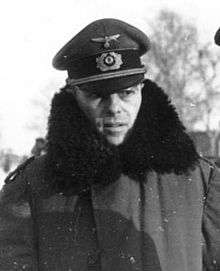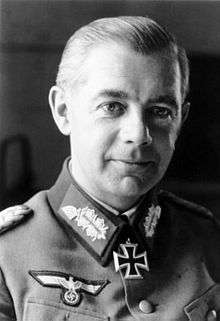Army Group A
Army Group A (Heeresgruppe A) was the name of several German Army Groups during World War II. During the Battle of France, the army group named Army Group A was composed of 45½ divisions, including 7 armored panzer divisions. It was responsible for breaking through the heavily-forested Ardennes region. The operation, which was part of Fall Gelb (Case Yellow), was resoundingly successful for the Germans, as the army group outflanked the best troops of France and its allies, eventually leading to France's surrender.[1]
| Army Group A | |
|---|---|
| Heeresgruppe A | |
| Country | |
| Insignia | |
| Identification symbol |  |
In 1942, Army Group South on the Eastern Front against the Soviet Union was split into Army Group A and Army Group B, and Army Group A was responsible for the invasion into the Caucasus. In 1945, months before the fall of Nazi Germany, Army Group A was renamed Army Group Centre.
Western Front, 1940
During the German invasion of the Low Countries and France Army Group A was under the command of Generaloberst Gerd von Rundstedt and was responsible for the break-out through the Ardennes. It was composed of 45½ divisions, including the 7 panzer divisions of Panzer Group Kleist.
Order of Battle
- 4th Army Generaloberst Günther von Kluge
- V Army Corps (Wehrmacht) General Infantry Richard Ruoff
- 211th Infantry Division - Generalmajor Kurt Renner
- 251st Infantry Division - Generalmajor Hans Kratzert
- 263rd Infantry Division - Generalmajor Franz Karl
- VIII Army Corps (Wehrmacht) General Infantry Ernst Busch
- 8th Infantry Division (Wehrmacht) GenLt Rudolf Koch-Erpach
- 28th Infantry Division (Wehrmacht) GenMaj Johann Sinnhuber
- II Army Corps (Wehrmacht) General Infantry Adolf Strauss
- XV Army Corps (Wehrmacht) General Infantry Hermann Hoth
- V Army Corps (Wehrmacht) General Infantry Richard Ruoff
- 12th Army Generaloberst Wilhelm List
- 16th Army General Infantry Ernst Busch
- Panzer Group Kleist
- XIX Army Corps (Wehrmacht) (Guderian)
- 2nd Panzer Division (Veiel)
- 1st Panzer Division (Kirchner)
- 10th Panzer Division (Schaal)
- Infantry Regiment Großdeutschland
- XLI Army Corps (Wehrmacht) (Reinhardt)
- 6th Panzer Division (Kempf)
- 8th Panzer Division (Kuntzen)
- 2nd Infantry Division (Wehrmacht) (Bader)
- XIV Army Corps (Wehrmacht) (Wietersheim)
- 13th Panzer Division (Rothkirch und Panthen)
- 29th Panzergrenadier Division (Langermann und Erlencamp)
- XIX Army Corps (Wehrmacht) (Guderian)
- Reserves
- XXXX Corps - Generalleutnant Georg Stumme
- 4th Infantry Division (Wehrmacht) GenLt Erick-Oskar Hansen
- 87th Infantry Division (Wehrmacht) GenLt Bogislav von Studnitz
- 211th Infantry Division (Wehrmacht) GenLt Kurt Renner
- 263rd Infantry Division (Wehrmacht) GenLt Franz Karl
- 267th Infantry Division (Wehrmacht) GenLt Ernst Fessmann
- XXXX Corps - Generalleutnant Georg Stumme
Eastern Front, 1942
In 1942, Army Group South was in southern Russia on the Eastern Front. For Case Blue (Fall Blau), the summer offensive of the German Armed Forces (Wehrmacht), Army Group South was split into Army Group A and Army Group B. Army Group A was ordered south to capture the oil fields in the Caucasus.
Army Group A included the following armies:
Eastern Front, 1944-1945
Army Group A was formed a third time on September 23, 1944 in southern Poland and the Carpathian region by renaming Army Group North Ukraine.
The army group was used to defend southern Poland and Slovakia.
Subordinate were :
- 9th Army,
- 4th Panzer Army
- the newly formed 17th Army
- 1st Panzer Army.
After the breakthrough of the Red Army near Baranow on the Vistula during the Soviet Vistula-Oder Offensive, on January 16, 1945 Colonel Bogislaw von Bonin, the Chief of the Operational Branch of the Army General Staff (Generalstab des Heeres) gave Heeresgruppe A permission to retreat rejecting a direct order from Adolf Hitler for them to hold fast. Although Heeresgruppe A escaped encirclement and regrouped, von Bonin was arrested by the Gestapo on January 19, 1945, and imprisoned.
On 25 January 1945 Hitler renamed three army groups. Army Group North became Army Group Courland; Army Group Center became Army Group North and Army Group A became Army Group Center.
Commanders
| No. | Commander | Took office | Left office | Time in office | |
|---|---|---|---|---|---|
| 1 | Generalfeldmarschall Gerd von Rundstedt (1875–1953) | 15 October 1939 | 1 October 1940 | 11 months | |
| 2 | Generalfeldmarschall Wilhelm List (1880–1971) | 10 July 1942 | 10 September 1942 | 2 months | |
| 3 | Adolf Hitler (1889–1945) | 10 September 1942 | 21 November 1942 | 2 months | |
| 4 | Generalfeldmarschall Ewald von Kleist (1881–1954) | 22 September 1942 | June 1943 | 6 months | |
| 5 | General der Gebirgstruppe Hubert Lanz (1896–1982) | June 1943 | July 1943 | 1 month | |
| (4) | Generalfeldmarschall Ewald von Kleist (1881–1954) | July 1943 | 25 March 1944 | 8 months | |
| 6 | Generaloberst Ferdinand Schörner (1892–1973) | 25 March 1944 | 31 March 1944 | 0 months | |
| 7 | Generaloberst Josef Harpe (1887–1968) | 28 September 1944 | 17 January 1945 | 3 months | |
| (6) | Generaloberst Ferdinand Schörner (1892–1973) | 17 January 1945 | 26 January 1945 | 0 months |
Chiefs of Staff
| No. | Chief of Staff | Took office | Left office | Time in office | |
|---|---|---|---|---|---|
| 1 | Generalleutnant Erich von Manstein (1887–1973) | 26 October 1939 | 1 February 1940 | 98 days | |
| 2 | General der Infanterie Georg von Sodenstern (1889–1955) | 6 February 1940 | 1 October 1940 | 238 days | |
| 3 | Generalleutnant Hans von Greiffenberg (1893–1951) | 10 July 1942 | 23 February 1943 | 228 days | |
| 4 | Generalleutnant Alfred Gause (1896–1967) | 23 February 1943 | 13 May 1943 | 79 days | |
| (3) | Generalleutnant Hans von Greiffenberg (1893–1951) | 13 May 1943 | 16 July 1943 | 64 days | |
| 5 | Generalleutnant Hans Röttiger (1896–1960) | 16 July 1943 | 24 March 1944 | 252 days | |
| 6 | Generalleutnant Walther Wenck (1900–1982) | 24 March 1944 | 22 July 1944 | 120 days | |
| 7 | Generalleutnant Wolf-Dietrich von Xylander (1903–1945) | 28 September 1944 | 15 February 1945 † | 208 days |
References
- Jackson, J. T. (2003). The Fall of France: The Nazi Invasion of 1940. Oxford: Oxford University Press. ISBN 978-0-19-280300-9.


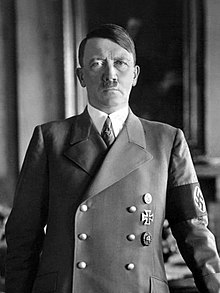

.jpg)
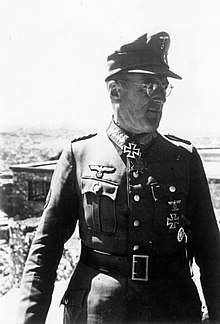
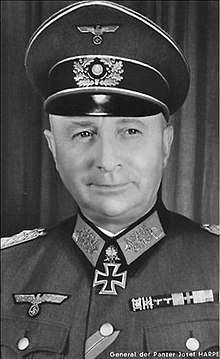



.jpg)
